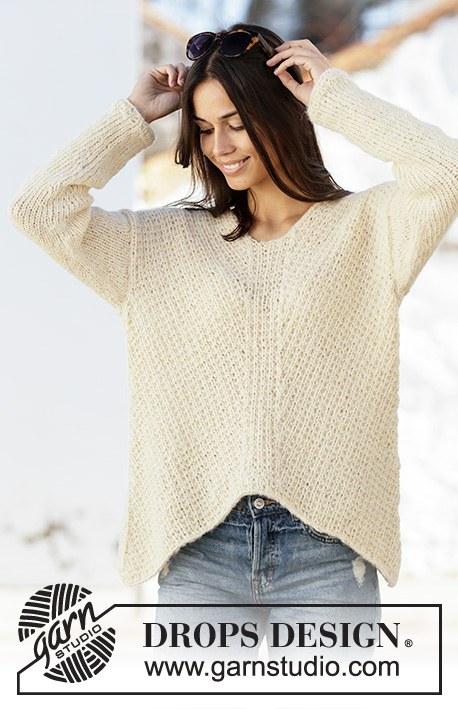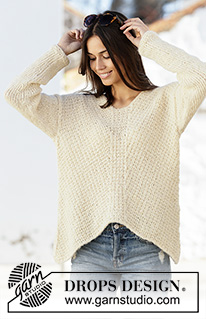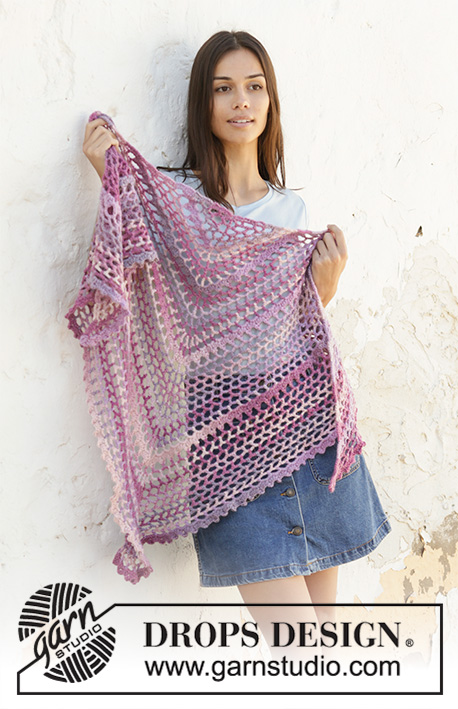Freedom Found |
||||||||||||||||
 |
 |
|||||||||||||||
Knitted jumper in DROPS Alpaca and DROPS Brushed Alpaca Silk. Piece is knitted with texture at an angle with V-neck, top down. Size: S - XXXL
DROPS 201-23 |
||||||||||||||||
|
---------------------------------------------------------- EXPLANATION FOR THE PATTERN: ---------------------------------------------------------- GARTER STITCH (back and forth): Knit all rows. 1 ridge vertically = knit 2 rows. PATTERN: See diagrams A.1 to A.4. DECREASE TIP (applies to back piece): All decreases are done from the right side! Work 1 stitch in garter stitch, slip 1 stitch knitwise, knit 1, pass slipped stitch over stitch worked, work until 3 stitches remain, knit 2 together, 1 stitch in garter stitch. INCREASE TIP (applies to sides on back piece): All increases are done from the right side. Work 1 stitch in garter stitch, knit 1, 1 yarn over, work until 2 stitches remain on row, 1 yarn over, knit 1 and 1 stitch in garter stitch. On next row work yarn overs twisted to avoid holes. Then work the new stitches in pattern. INCREASE TIP (applies to sleeves): Work until 2 stitches remain before marker thread, 1 yarn over, knit 4 (marker thread is in the middle of these stitches), 1 yarn over. On next round knit yarn overs twisted to avoid holes. Then work the new stitches in stocking stitch. ---------------------------------------------------------- START THE PIECE HERE: ---------------------------------------------------------- JUMPER - SHORT OVERVIEW OF THE PIECE: Worked back and forth in several pieces and sewn together when finished. Work sleeves in the round on double pointed needles/a short circular needle. FRONT PIECE: RIGHT SHOULDER: Cast on 33-35-39-43-45-49 stitches (including 1 edge stitch in each side) on circular needle size 5.5 mm with 1 strand Alpaca and 1 strand Brushed Alpaca Silk (= 2 strands). Purl 1 row from wrong side. Work next row as follows from right side: Work 1 stitch in garter stitch, A.1a (= 3 stitches), repeat A.1b until 1 stitch remains (= 14-15-17-19-20-22 repetitions of 2 stitches), and finish with 1 stitch in garter stitch. When 2 rows have been worked, continue this pattern AT THE SAME TIME on next row work short rows as follows, begin from right side: Work over the first 25-27-31-31-35-37 stitches, turn, tighten yarn and work back from wrong side. Work over the first 17-19-21-21-23-25 stitches, turn, tighten yarn and work back from wrong side. Work over the first 9-9-11-11-11-13 stitches, turn, tighten yarn and work back from wrong side. Then work over all the 33-35-39-43-45-49 stitches - REMEMBER THE KNITTING TENSION! When piece measures 17-18-19-20-21-22 cm along the shortest side, i.e. towards the neck (= approx. 19-20-21-22-23-24 cm towards armhole), finish after row from wrong side. Cut the yarn. Put piece aside and work the left shoulder. LEFT SHOULDER: Cast on 33-35-39-43-45-49 stitches (including 1 edge stitch in each side) on circular needle size 5.5 mm with 1 strand Alpaca and 1 strand Brushed Alpaca Silk (= 2 strands). Purl 1 row from wrong side. Work next row as follows from right side: Work 1 stitch in garter stitch, A.1a (= 3 stitches), work A.1b until 1 stitch remains (= 14-15-17-19-20-22 repetitions of 2 stitches), and finish with 1 stitch in garter stitch. When 3 rows have been worked, continue this pattern AT THE SAME TIME on next row work short rows as follows, begin from wrong side: Work over the first 25-27-31-31-35-37 stitches, turn, tighten yarn and work back from right side. Work over the first 17-19-21-21-23-25 stitches, turn, tighten yarn and work back from right side. Work over the first 9-9-11-11-11-13 stitches, turn, tighten yarn and work back from right side. Then work over all the 33-35-39-43-45-49 stitches. When piece measures 17-18-19-20-21-22 cm along the shortest side, i.e. towards the neck (= approx. 19-20-21-22-23-24 cm towards armhole) - adjust according to right shoulder, finish after row from wrong side. Cut the yarn. FRONT PIECE: Slip right shoulder on to same circular needle size 5.5 mm as left shoulder – make sure that the short rows are in each side of piece and that the shortest sides are against the neck = 66-70-78-86-90-98 stitches. Now work right shoulder together with left shoulder as follows - from right side: Cast on 4-4-4-4-6-6 new stitches on needle for armhole, work A.1b over the next 32-34-38-42-44-48 stitches (= 16-17-19-21-22-24 repetitions of 2 stitches), work 1 stitch in garter stitch, (= right shoulder), cast on 5 new stitches on needle (= middle piece), continue over left shoulder as follows: Work A.1b over the first 32-34-38-42-44-48 stitches (= 16-17-19-21-22-24 repetitions of 2 stitches), work 1 stitch in garter stitch and finish by casting on 4-4-4-4-6-6 new stitches on needle for armhole (= left shoulder) = 79-83-91-99-107-115 stitches. Work row back from wrong side. Then work as follows from right side: Work 1 stitch in garter stitch, work A.2a over the next 2 stitches, work A.2b over the next 24-26-30-34-38-42 stitches (= 12-13-15-17-19-21 repetitions of 2 stitches), work A.2c over the next 9 stitches, work A.3 over the next 7 stitches (= middle piece) work A.4a over the next 9 stitches, work A.4b over the next 24-26-30-34-38-42 stitches (= 12-13-15-17-19-21 repetitions of 2 stitches), work A.4c over the next 2 stitches and finish with 1 stitch in garter stitch. When A.2 and A.4 have been worked vertically, 4 stitches have been increased in total = 83-87-95-103-111-119 stitches on needle. Repeat this pattern, every time A.2 to A.4 have been worked 1 time vertically, work 1 repetition more of A.2b and A.4b in width. Work until piece measures 39-40-41-42-43-44 cm straight up from middle piece, loosely cast off with knit over knit and purl over purl from right side. BACK PIECE: RIGHT SHOULDER: Cast on 33-35-39-43-45-49 stitches (including 1 edge stitch in each side) on circular needle size 5.5 mm with 1 strand Alpaca and 1 strand Brushed Alpaca Silk (= 2 strands). Purl 1 row from wrong side. Work next row as follows from right side: Work 1 stitch in garter stitch, work A.1b over the remaining stitches (= 16-17-19-21-22-24 repetitions of 2 stitches). When 3 rows have been worked, continue this pattern AT THE SAME TIME on next row work short rows as follows, begin from wrong side: Work over the first 25-27-31-31-35-37 stitches, turn, tighten yarn and work back from right side. Work over the first 17-19-21-21-23-25 stitches, turn, tighten yarn and work back from right side. Work over the first 9-9-11-11-11-13 stitches, turn, tighten yarn and work back from right side. Work over all the 33-35-39-43-45-49 stitches, turn and work back from right side. Cut the yarn. Put piece aside and work the left shoulder. LEFT SHOULDER: Cast on 33-35-39-43-45-49 stitches (including 1 edge stitch in each side) on circular needle size 5.5 mm with 1 strand Alpaca and 1 strand Brushed Alpaca Silk (= 2 strands). Purl 1 row from wrong side. Work next row as follows - from right side: Work A.1b until 1 stitch remains (= 16-17-19-21-22-24 repetitions of 2 stitches) and finish with 1 stitch in garter stitch. When 2 rows have been worked, continue this pattern AT THE SAME TIME on next row work short rows as follows, begin from right side: Work over the first 25-27-31-31-35-37 stitches, turn, tighten yarn and work back from wrong side. Work over the first 17-19-21-21-23-25 stitches, turn, tighten yarn and work back from wrong side. Work over the first 9-9-11-11-11-13 stitches, turn, tighten yarn and work back from wrong side. Work over all the 33-35-39-43-45-49 stitches, turn and work back from wrong side. Do not cut the yarns! BACK PIECE: Slip right shoulder on to same circular needle size 5.5 mm as left shoulder – make sure that the short rows in each side of piece and that the shortest sides are against the neck = 66-70-78-86-90-98 stitches. Now work left shoulder together with right shoulder as follows - from right side: Work A.1b until 1 stitch remains on left shoulder (= 16-17-19-21-22-24 repetitions of 2 stitches), work 1 stitch in garter stitch, cast on 17-17-17-19-19-19 new stitch on needle (= neck), work A.1b until 1 stitch remains on right shoulder (= 16-17-19-21-22-24 repetitions of 2 stitches) and finish with 1 stitch in garter stitch. On next row work the new stitches in pattern. Continue this pattern, at the same time decrease 1 stitch in each side on next row from right side - read DECREASE TIP. Decrease like this every 6th row 1-1-2-2-4-4 times in total, then every 4th row 5-4-4-5-3-3 times in total = 71-77-83-91-95-103 stitches on needle. When piece measures 19-20-21-22-23-24 cm along one armhole, cast on 4-4-4-4-6-6 new stitches at the end of the next 2 rows for armholes = 79-85-91-99-107-115 stitches. Continue pattern as before over all stitches. When piece measures 3 cm, increase 1 stitch in each side - read INCREASE TIP. Increase like this every 6-5½-6-6-9-12 cm 7-8-7-7-5-4 times in total = 93-101-105-113-117-123 stitches. Work until piece measures 62-64-66-68-70-72 cm from shoulder (towards the neck) and down. Cast off stitches with knit over knit and purl over purl. SLEEVE: Cast on 32-34-36-36-38-40 stitches on double pointed needles size 5.5 mm with 1 strand Alpaca + 1 strand Brushed Alpaca Silk (= 2 strands). Work A.1b (= 2 stitches) the entire round. Work 4 rounds in total. Insert 1 marker at beginning of round = mid under sleeve. Then work in stocking stitch in the round - REMEMBER THE KNITTING TENSION! When piece measures 8-9-8-8-8-9 cm, increase 2 stitches mid under sleeve - READ INCREASE TIP above. Increase like this every 3-2½-2½-2-2-1½ cm 12-13-13-15-15-16 times in total = 56-60-62-66-68-72 stitches. Continue with stocking stitch without increases until piece measures 42-41-40-37-36-34 cm (shorter measurements in the larger sizes because of wider shoulders and longer sleeve cap). The piece is now split at the marker mid under sleeve and worked back and forth until finished measurements. Insert 1 marker in each side, markers mark where sleeve should be sewn into armhole. Work back and forth until piece measures 45-44-43-41-39-38 cm. Then loosely cast off stitches with knit over knit and purl over purl. Work the other sleeve the same way. ASSEMBLY: Sew shoulder seams inside cast-on edge. Sew side seams inside 1 edge stitch. Sew in sleeves inside 1 edge stitch in each side on front and back piece. Marks on sleeves should fit bottom of armhole. |
||||||||||||||||
Diagram explanations |
||||||||||||||||
|
||||||||||||||||

|
||||||||||||||||

|
||||||||||||||||

|
||||||||||||||||
|
Have you made this or any other of our designs? Tag your pictures in social media with #dropsdesign so we can see them! Do you need help with this pattern?You'll find tutorial videos, a Comments/Questions area and more by visiting the pattern on garnstudio.com. © 1982-2024 DROPS Design A/S. We reserve all rights. This document, including all its sub-sections, has copyrights. Read more about what you can do with our patterns at the bottom of each pattern on our site. |
||||||||||||||||









































































Comments / Questions (49)
Liebes DropsTeam, ich habe die Fragen / Antworten zwar schon gelesen, habe aber Probleme mit den Hin- und Rückreihen. Z.B: am Vorderteil rechte Schulter, ich nehme die Maschen auf, stricke dann eine Reihe links. Muss die nächste Reihe glatt rechts - so wie die 1.Zeile in den Diagrammen 1a und 1b abgebildet sind gestrickt werden, oder beginne ich in der 2.Zeile und stricke mit Muster? Vielen Dank und viele Grüße, Ute
15.02.2021 - 17:32DROPS Design answered:
Liebe Ute, hier ist die erste Reihe eine Rückreihe, die links gestrickt wird, dh die nächste Reihe ist eine Hinreihe, bei den Diagrammen stricken Sie alle Maschen rechts, bei den Rückreihen in Diagramm stricken Sie dann die Maschen mit einem X rechts (= krausrechte Maschen) und die leere Kästchen links (= glatt rechts). Viel Spaß beim stricken!
16.02.2021 - 09:05Un gros, gros merci, cette information va me permettre de continuer mon tricot. Je profite pour vous remercier de la rapidité dans vos réponses, bonne journée.
08.02.2021 - 10:31Merci pour votre réponse et je comprends au sujet de la traduction. Concernant ce modèle, pouvez-vous m’aider stp? J'ai mis l'épaule droite et gauche ensembles et j'ai fais une séquence de A.2.a à A.4c. Et ensuite, je ne sais plus comment continuer. Merci encore
07.02.2021 - 11:50DROPS Design answered:
Bonjour Beatriz, quand les diagrammes ont été tricotés 1 fois en hauteur, reprenez-les au début: A.2a, répétez A.2b jusqu'à A.2c (= 9 m avant les 7 m centrales de A.3), A.2c, A.3, A.4a, A.4b et terminez par A.4c, autrement dit, vous augmentez au début et à la fin du rang (A.2a et A.4c) et vous diminuez de part et d'autre de A.3 (= A.2c et A.4a). Bon tricot!
08.02.2021 - 09:37Bonjour, la traduction est parfois incompréhensible, serait-il possible de faire en sorte qu'elle ne soit pas textuelle et plutôt faire corriger par quelqu'un qui connaît la terminologie du tricot. Il serait plus facile pour les tricoteuses. Merci
02.02.2021 - 22:59DROPS Design answered:
Bonjour Beatriz, les modèles DROPS sont tricotés et crochetés par des centaines de tricoteuses du monde entier. Nous comprenons toutefois qu'en fonction des pays, avec des traditions différentes de celles de la Scandinavie, nos modèles puissent paraître être écrits différemment que ceux que vous connaissez. Raison pour laquelle nous avons une liste de vidéos et de leçons pour les techniques et les diagrammes utilisés. Et vous pouvez aussi poser votre question dans cette rubrique. Bon tricot!
03.02.2021 - 09:02Hi. Möchte diesen tollen Pulli stricken, hänge leider am ersten Teil fest sprich bei Vorderteil re. Schulter. Letzte Reihe bei einer Länge von 18 cm an der kürzesten Seite , d.h am Halsrand 20cm Armausschnitt. Was bedeutet das genau muss ich 20cm hoch stricken?
28.01.2021 - 17:02DROPS Design answered:
Liebe Zoi, nachdem Sie die verkürzten Reihen gestrickt haben, stricken Sie alle Maschen weiter wie zuvor (= mit A.1) bis die Schulter 18 cm am Halsrand und 20 cm am Armausschnitt misst. (Unterschied ist wegen den verkürzten Reihen). Viel Spaß beim stricken!
29.01.2021 - 07:17Hi. I'm working on the sleeves for Freedom Found garment. I'm using magic loop method and not quite sure how to split the sleeve and work it back and forth? Also, I'm using Yarn A + C and wonder should I block the garment when it's finished?
28.10.2020 - 09:52DROPS Design answered:
Dear Mrs Browne, the sleeve is then divided at the beg of the round, this means you should now work rows from mid under sleeve (= where you joined and where you increased, ie in the middle of 2 sts where you increased) and turn at the end of each row. You can block if you like to, some knitters rather block everything, some other never block. Your DROPS store might have even more tipps for you. Do not hesitate to contact them. Happy knitting!
28.10.2020 - 15:26Bonjour,je ne tricote qu'avec des aiguilles normal ,comment faire ce modele car tous vos modeles sont avec aiguille circulaire et personnellement je n arrive pas a tricoter . merci.
23.10.2020 - 16:23DROPS Design answered:
Bonjour Sandrine! Regardez la lecon DROPS sur ce sujet ICI. Bon tricot!
23.10.2020 - 16:39Wollte noch mal ein update geben, ist ein toller pulli geworden, den ich zwar etwas anders gestrickt habe, aber er sieht trotzdem klasse aus. (im Rippenmuster gestrickt, anstatt Zunahmen Abnahmen gemacht, sodass er in der Taille nicht auseinandergeht, sondern taillenbetont ist. Ärmel habe ich auch anders gestrickt. Aber man sieht trotzdem das Grundmuster:-)
19.09.2020 - 20:13Hallonochmal, die Hin- und Rückreihen sind hier etwas unklar. ich habe die Hin und Rückreihen entweder vertauscht oder sie sind bei a.4a und a.4c vertauscht worden,habe ich jetzt geändert, die Hinreihen bei a.4a und a.4c sind nicht rechts gestrickt sondern Muster a.1b, ansonsten kommt es nicht hin. Nund hebt sih auch der Mittelteil heraus. Grüße
27.07.2020 - 08:13DROPS Design answered:
Liebe Lydia, Sie stricken beim Zusammensetzen der Teile 2 Reihen von A.1b, also 1 Hin-Reihe und 1 Rück-Reihe. Mit A.2, A.3 und A.4 beginnen Sie dann wieder mit der Hin-Reihe, daher sollte das eigentlich passen. Alle Diagramme beginnen dabei mit 1 Reihe glatt rechts ohne Strukurmusterung. A.2a und A.4c haben in der ersten Reihe einen Zunahme-Umschlag zwischen den beiden Maschen, vielleicht haben Sie das falsch interpretiert? Gutes Gelingen!
27.07.2020 - 10:30Hallo, leider gleicht der mittlere Teil unterm Halsausschnitt nicht dem auf dem Foto. (7 m rechts, 9 m r, 7 r) auf dem Foto wirkt es strukturrell,bei mir eben/glatt. Könnte es sein,dass der Pulli auf dem Foto nicht 1:1 der aus der Strickanleitung ist; denn der Mittelteil hebt sich bei mir nicht heraus. Vielen Dank für eine Antwort,Grüße
26.07.2020 - 18:04DROPS Design answered:
Liebe Lydia, den mittleren Teil des Vorderteils stricken Sie wie folgt: A.2c über 9 Maschen, A.3 über 7 Maschen (= Halsausschnitt) A.4a über 9 Maschen. A.3 wird dabei nicht glatt rechts gestrickt, sondern ist auch das Strukturmuster, d.h. abwechselnd wird 1 Reihe rechts und 1 Reihe mit 1 Masche rechts + 1 Masche links gestrickt. Gutes Gelingen weiterhin!
27.07.2020 - 10:05